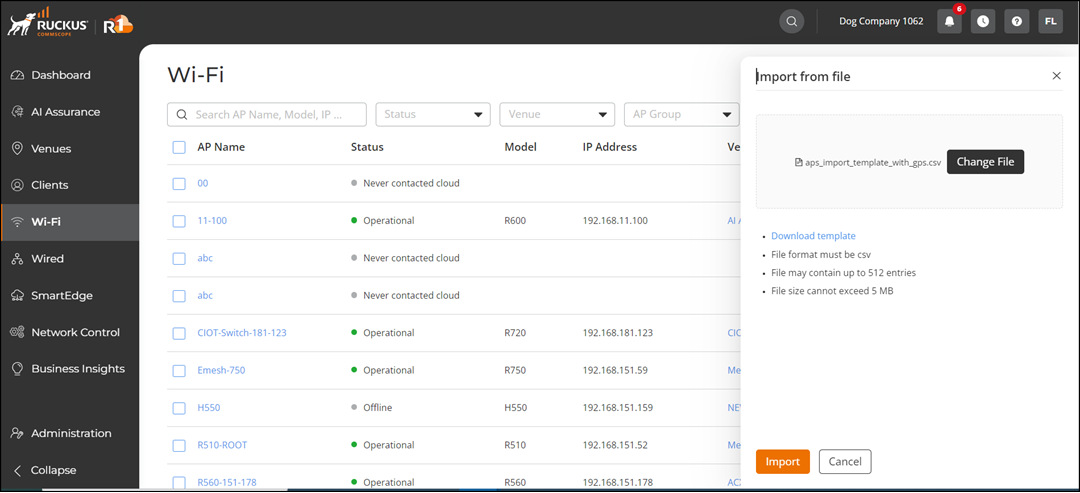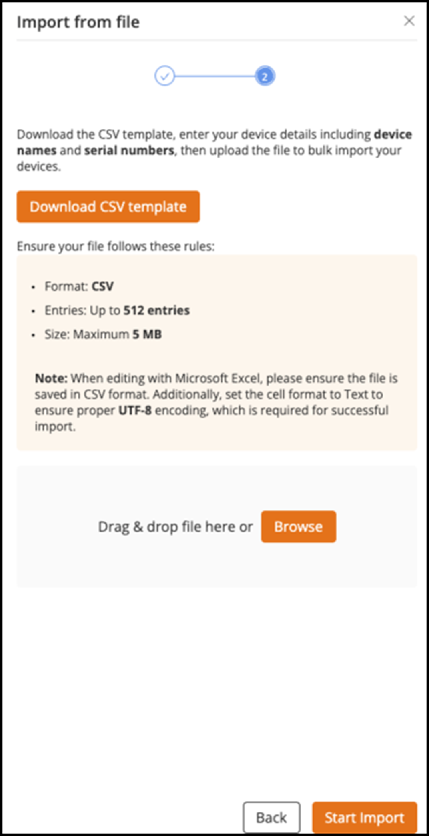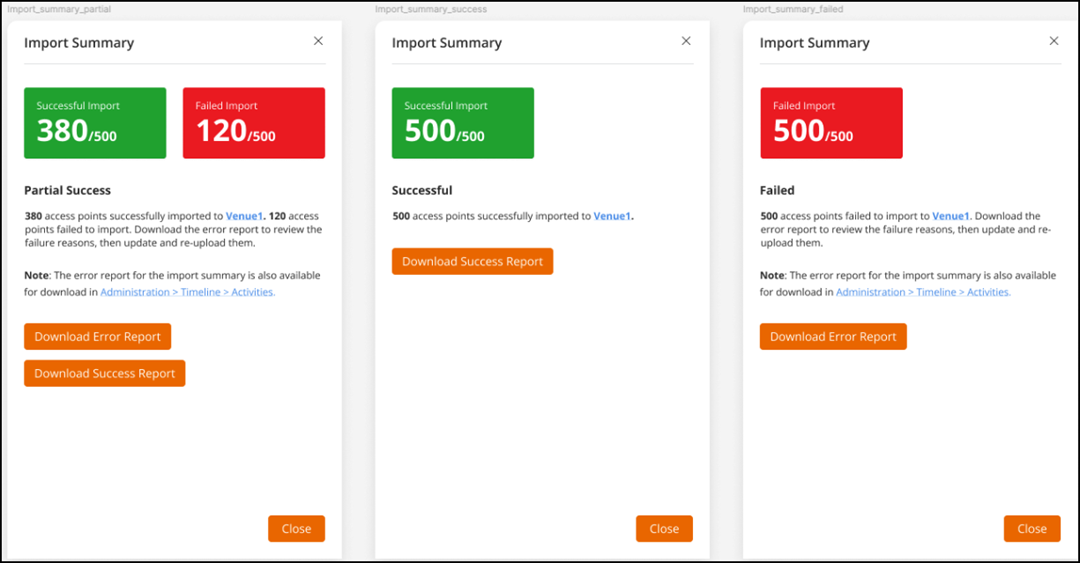Adding APs in Bulk
If you want to add multiple access points (APs) to your RUCKUS One account simultaneously, instead of adding them one by one, you can import them into your RUCKUS One account using a comma-separated value (.CSV) file. Using the .CSV template, you can import up to 512 APs at the same time.
The CSV import functionality is compatible with the following browsers:
- Microsoft Edge
- Google Chrome
- Mozilla Firefox
- Safari
-
On the navigation bar, select
Wi-Fi > Access
Points > AP
List.
The Access Points page is displayed.
Access Points - AP List Tab 
-
On the upper-right corner of
the page, click Add and from the menu, select Import APs.
The Import from file sidebar is displayed.
Import from File - Select Target Venue 
-
Select the Target
Venue where you want to import the APs from the drop-down
list.
If the venue is not yet defined, click Add, complete the fields in the Add New Venue sidebar, and then select the new venue from the Target Venue drop-down.
-
Click Next.
The Download CSV Template option appears.
Import from file - Download CSV Template 
- (Recommended) Click Download CSV template to download the CSV template to your local machine. Populate the file with the required information as prescribed in the template.
-
Using a spreadsheet application,
open the .CSV file.
Use one of the following applications to edit the CSV file: Google Sheets, Microsoft Excel, or Apple Numbers.
Note: If you use MS Excel to edit a CSV file, set every column cell format to Text (using CSV function Format cells... > Number > Text) before pasting or typing data. This ensures that the data (for example, a serial number) is not automatically converted into scientific notation (which will be treated as invalid).Note: When you edit data in Apple Numbers, the following checks should be completed before initiating a CSV export.Refer to Standards for Importing a CSV File for details pertaining to application-specific editing requirements.- Do not check the Include table name option. Enabling the option inserts an extra line above the header row, which breaks the expected file format and causes import errors.
- Set Encoding to Unicode (UTF-8) to ensure proper character formatting.
-
Complete the following fields to
identify the AP:
- AP Name: Enter the name to be assigned to the AP.
- Serial number: Enter the serial number of the AP.
- (Optional) Description: Enter a short description to be assigned to the AP.
- (Optional) AP
Group: Enter the AP group name.
If the group exists in the venue, RUCKUS One assigns the AP to that group. If the group does not exist, RUCKUS One creates a new AP group during import, as long as the venue has not reached its limit of 511 custom AP groups and one default AP group. If you leave this field empty, RUCKUS One adds the AP to the default AP group.
- (Optional) Tags: Enter one or more AP tags.
- (Optional) Latitude: Enter the latitude coordinate ranging between -90 to 90 degrees.
- (Optional) Longitude: Enter the longitude coordinate ranging between -180 to 180 degrees.
- (Optional) Global Untagged VLAN ID: Allows you to define a VLAN ID that is automatically applied to all downstream access ports when an access point connects to the cloud. This ensures consistent VLAN tagging across the network without requiring manual configuration for each port.
Location Data Guidelines for APs- Provide both latitude and longitude for each AP to ensure accurate results.
- Verify that coordinates fall within the country where the venue is registered.
Note: Remove any leading or trailing spaces from the data fields.Note: Do not modify the header line under the Actual Data Section in the CSV template. - Save the CSV file.
-
In the GUI, drag and drop the
CSV file, or click Browse to locate the CSV file and click
Open to upload it.
Ensure that the file you import adheres to the standards prescribed in Standards for Importing a CSV File.
-
Click Start Import.
The Import Summary is displayed, providing the number of APs that were imported successfully and failed, along with a hyperlink to the target venue. It also provides up to three reports: a success report, a partial success report, and an error report. Depending on the result, you will see one of the following:
- Successful: Displays how many devices were imported successfully and provides a button to download the success report.
- Partial Success: Displays how many devices were imported successfully and how many failed, and provides buttons to download both the success and error reports.
- Failed: Displays how many devices failed to
import and provides a button to download the error report. If the
failure relates to an AP group, check the following CSV errors:
- The venue has reached the AP group limit. Remove unused AP groups and import again.
- The AP group name is invalid. An AP group name must contain 2 to 64 characters cannot include special characters such as back-tick (`) or the sequence "$(".
Import Summary Examples 
The failed report can be reused without removing the failure reasons. Correct the failed entries and re-import the file.
-
(Optional) You can download the
error report by clicking the Download Error Report
button or success report by clicking the Download Success Report
button.
The report file is downloaded to your local system. Review the error report, correct the failed entries in the CSV file, and re-import the file to complete the process.Note: The error report for the import summary is also available for download in Administration > Timeline > Activities.